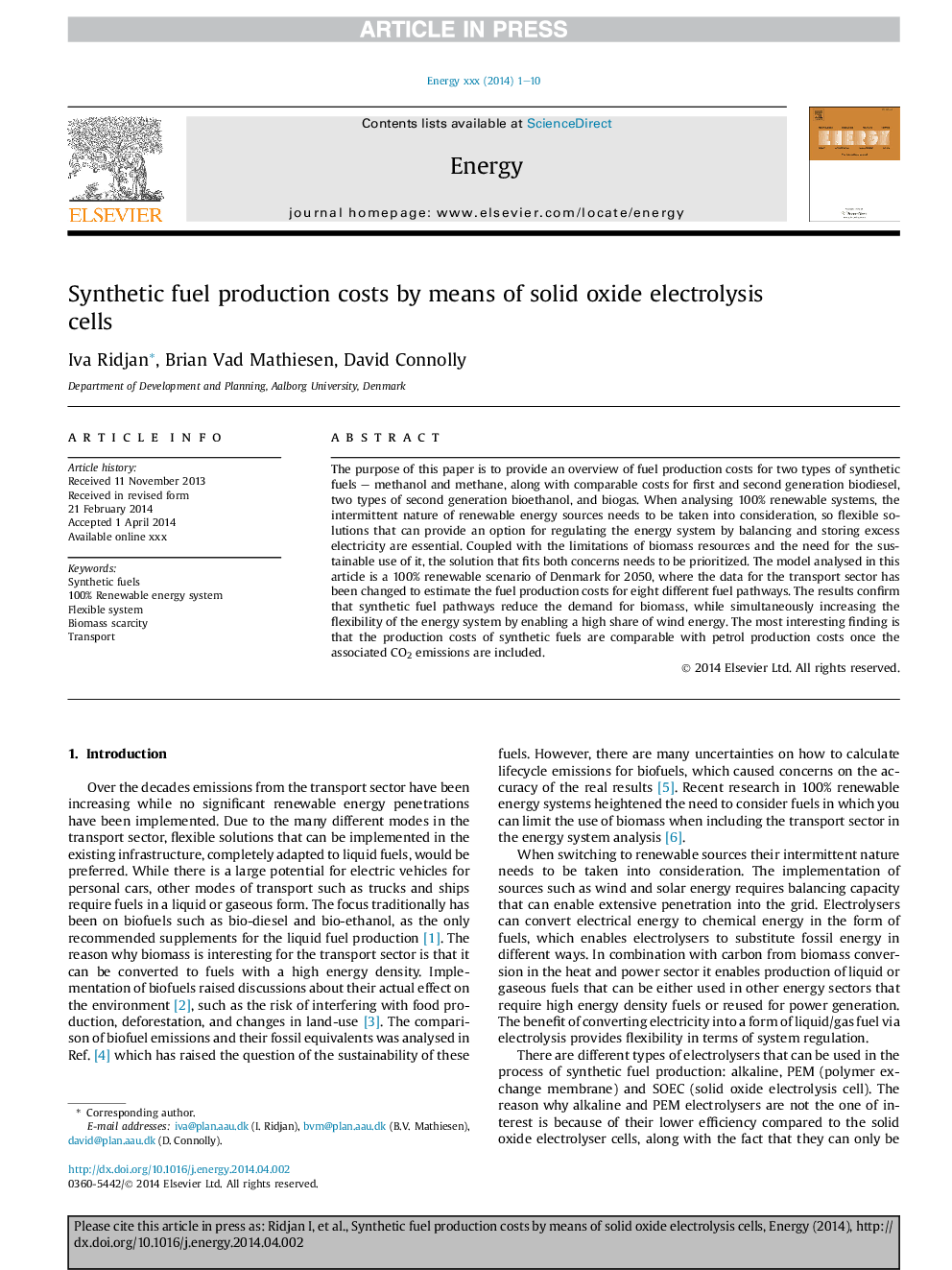| کد مقاله | کد نشریه | سال انتشار | مقاله انگلیسی | نسخه تمام متن |
|---|---|---|---|---|
| 8076519 | 1521470 | 2014 | 10 صفحه PDF | دانلود رایگان |
عنوان انگلیسی مقاله ISI
Synthetic fuel production costs by means of solid oxide electrolysis cells
ترجمه فارسی عنوان
هزینه های تولید مصنوعی سوخت با استفاده از سلول های الکترولیز اکسید جامد
دانلود مقاله + سفارش ترجمه
دانلود مقاله ISI انگلیسی
رایگان برای ایرانیان
کلمات کلیدی
سوخت های مصنوعی، سیستم انرژی قابل تجدید 100٪، سیستم انعطاف پذیر، کمبود زیست توده، حمل و نقل،
ترجمه چکیده
هدف از این مقاله ارائه یک نظرسنجی از هزینه های تولید سوخت برای دو نوع سوخت مصنوعی - متانول و متان همراه با هزینه های قابل مقایسه برای نسل اول و دوم بیودیزل، دو نوع نسل دوم بیوتکنول و بیوگاز است. هنگام تجزیه و تحلیل 100٪ سیستم های قابل تجدید، طبیعت متناوب منابع انرژی تجدید پذیر باید مورد توجه قرار گیرد، بنابراین راه حل های انعطاف پذیر می توانند گزینه ای برای تنظیم سیستم انرژی با تعادل و ذخیره سازی برق اضافی ضروری باشند. همراه با محدودیت منابع زیست توده و نیاز به استفاده پایدار از آن، راه حل که متناسب با هر دو نگرانی است باید اولویت بندی شود. مدل مورد تجزیه و تحلیل در این مقاله یک سناریو 100٪ تجدید پذیر از دانمارک تا سال 2050 است، جایی که داده ها برای بخش حمل و نقل برای تخمین هزینه های تولید سوخت برای هشت راه مختلف سوخت تغییر کرده اند. نتایج نشان می دهد که مسیرهای مصنوعی سوخت، تقاضای زیست توده را کاهش می دهند، در عین حال افزایش انعطاف پذیری سیستم های انرژی با سهولت بیشتر از انرژی باد را افزایش می دهد. جالب ترین یافته این است که هزینه های تولید سوخت های مصنوعی با هزینه های تولید بنزین در مقایسه با انتشار گازهای همراه شامل می شود.
موضوعات مرتبط
مهندسی و علوم پایه
مهندسی انرژی
انرژی (عمومی)
چکیده انگلیسی
The purpose of this paper is to provide an overview of fuel production costs for two types of synthetic fuels - methanol and methane, along with comparable costs for first and second generation biodiesel, two types of second generation bioethanol, and biogas. When analysing 100% renewable systems, the intermittent nature of renewable energy sources needs to be taken into consideration, so flexible solutions that can provide an option for regulating the energy system by balancing and storing excess electricity are essential. Coupled with the limitations of biomass resources and the need for the sustainable use of it, the solution that fits both concerns needs to be prioritized. The model analysed in this article is a 100% renewable scenario of Denmark for 2050, where the data for the transport sector has been changed to estimate the fuel production costs for eight different fuel pathways. The results confirm that synthetic fuel pathways reduce the demand for biomass, while simultaneously increasing the flexibility of the energy system by enabling a high share of wind energy. The most interesting finding is that the production costs of synthetic fuels are comparable with petrol production costs once the associated CO2 emissions are included.
ناشر
Database: Elsevier - ScienceDirect (ساینس دایرکت)
Journal: Energy - Volume 76, 1 November 2014, Pages 104-113
Journal: Energy - Volume 76, 1 November 2014, Pages 104-113
نویسندگان
Iva Ridjan, Brian Vad Mathiesen, David Connolly,
